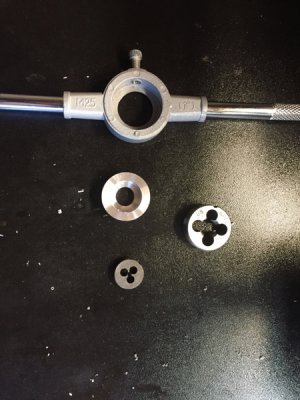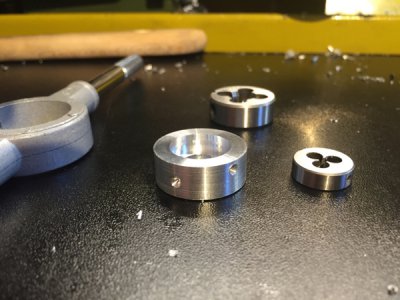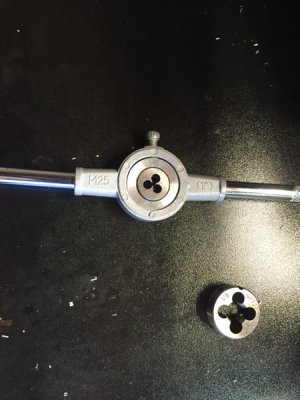-
Welcome back Guest! Did you know you can mentor other members here at H-M? If not, please check out our Relaunch of Hobby Machinist Mentoring Program!
- Forums
- THE PROJECTS AREA
- PROJECT OF THE DAY --- WHAT DID YOU DO IN YOUR SHOP TODAY?
- Project of the Day Mega-Thread Archives
You are using an out of date browser. It may not display this or other websites correctly.
You should upgrade or use an alternative browser.
You should upgrade or use an alternative browser.
2016 POTD Thread Archive
- Thread starter sanddan
- Start date
T
TOOLMASTER
Forum Guest
Register Today
trust is everything ;-)
Amazing!Yes I do, that titanium sheet has 770lbs of force holding it to the chuck thanks to vacuum....
- Joined
- Apr 26, 2014
- Messages
- 243
That is awesome. Thank you for posting. Could you possibly take a close-up of how you have the cutter ground??Boy, have I got balls! Needed to make ball shaped ends on bat handles. Many would go to the lathe and plunge it with a form tool or use a ball turner. Through the years I have migrated over to the mill using a fly cutter and whatever device to rotate the part. For me this method is MUCH faster, more accurate and safer. One of the pics is showing the boring head with cutter. The cutter is rather long in this set-up, should be shorter for best rigidity. The cutter was from my last job that needed more length. I tried it on this job and was OK so went with it. Next will be polish the ends that I just made, the straight knurl, cut it off and make the center hub. All the ball ends in the pic maybe took ½ hour to make…Dave.View attachment 135490 View attachment 135491
- Joined
- Jan 22, 2011
- Messages
- 8,031
Until you do some work with vac chucks and learn to trust them....it seems nearly impossible for it to work. But they do. Even though atmospheric pressure is only 14.7 psi at sea level, those square inches add up pretty quickly. If it's done right, there's no way you can take a part off a vac plate with your hands. They are used quite a bit in aircraft machining, because there are all sort of odd shaped parts. It requires a lot of planning though, because obviously you need as much flat surface as possible, and fancy fixturing as the last steps to remove those used to hold the part on the vac chuck/plate.
- Joined
- Aug 19, 2013
- Messages
- 764
Yes I do, that titanium sheet has 770lbs of force holding it to the chuck thanks to vacuum....
It's usually surprising what a good vacuum pump can do to hold parts. When one adds up the area in sq. inches and multiplies by 14+ it ad ds up quickly. At one sign company where I worked we used vacuum to hold printed decals in plastic injection mold dies. We used a venturi pump and compressed air to produce the vacuum. At the end of the molding cycle we restricted the outlet of the venturi thus forcing air out through the "ports" in the mold and ejecting the parts without needing ejector pins. The decals were about 25 square inches of piston area which readily resisted the flow and pressure of the hot plastic.
Last edited:
- Joined
- Nov 23, 2014
- Messages
- 2,609
OK, been a while since I was in school . . . the hold down force would be 14.7 psi times the surface area of the vacuum surface. If you had a pure vacuum pulled over a 10" x 10" surface area you'd have a hold down force of 1470 lbs. Like Uncle Harry said above.Been a long time since posted anything, but that doesn't mean I haven been busy, here's a vacuum chuck I made, it's modeled slightly after the Mitee bite vm100, 6x12.75 I machined it from 1" Alcoa MIC6 cast plate. It has slots on the sides for the clamps I made for it (not shown). I fly cut both sides and got a thickness variation of about 5 tenths across the entire chuck. The finish pass on the work side took an hour and 45mins to do, .005 doc, 1/4" minute. I'm using an electric vacuum pump, holding an 1/8th thick sheet of titanium down I pulled pretty good and couldn't break the seal.
I still need to sand blast the surface for some traction. I also intend to drill and ream locating holes for pins around the perimeter, I may also drill and tap all the squares. Additionally I would like to add larger locating pins to use it as a sub plate/pallet changer. I'm about $60 into the chuck not including the pump. Also had to make a small modification to the brass flare nut as seen being held in the Bison
View attachment 135641 View attachment 135642 View attachment 135643 View attachment 135644 View attachment 135649
Bruce
- Joined
- Dec 30, 2014
- Messages
- 259
Can you describe the pump used? Is this something the typical garage hobby guys like me should stay away from? Looks like a really interesting addition to a machinists collection of shop made stuff! I assume the rubber gasket is placed around the permitted to match the shape being milled and provides the seal for the the vacuum?
Thanks for posting.
Thanks for posting.
I got a good deal on an m2 die. However when it arrived it turned out to be 16mm in diameter, and my die handle only takes 25 mm dies.....
So i got some time on the lathe and made an adapter:



Seems to fit nicely. Just need a short m3 setscrew to secure the small die and will be all set.
Sent from my iPhone using Tapatalk
So i got some time on the lathe and made an adapter:



Seems to fit nicely. Just need a short m3 setscrew to secure the small die and will be all set.
Sent from my iPhone using Tapatalk

